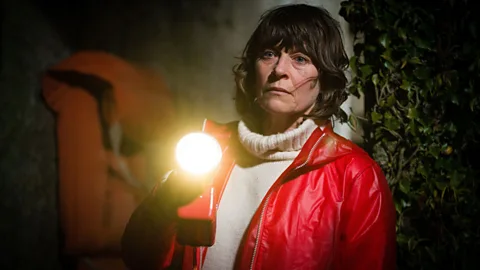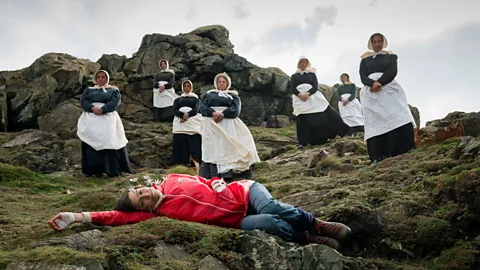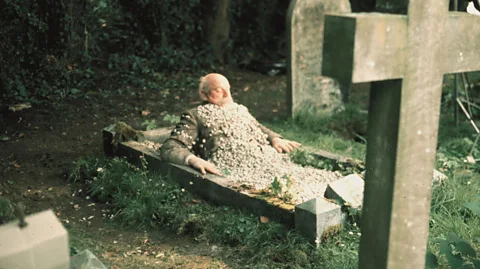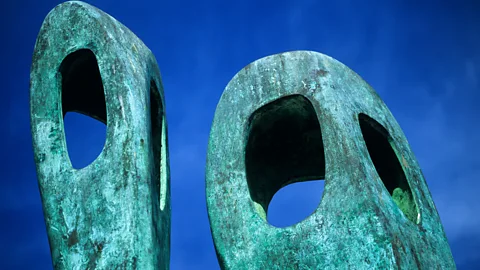Enys Men: The films that frighten us in unexplainable ways
 Steve Tanner
Steve TannerBait director Mark Jenkin's new film about a woman having visions on a Cornish island will haunt audiences like few others. It fits into a strong tradition of strangely unsettling, "eerie" work, writes Adam Scovell.
Eeriness has long been a sensation that we have understood as intangible: an eerie location or situation is one where a person can feel frightened or unsettled for reasons beyond their comprehension. In that way, there is some overlap between "the eerie" and Sigmund Freud's feelings of Das Unheimliche or "the uncanny", where unspecified familiarity with an event renders it unnerving.
More like this:
– The strange allure of ancient stone circles
But while eeriness is, by its very nature, elusive, "the eerie" is something that over the last decade or so particularly, critics and academics have tried to define more thoroughly, particularly in relation to art. Now it is understood as the foundation of a body of work that commonly deals in haunted landscapes and unexplained dread.
 Steve Tanner
Steve TannerIn a 2015 essay for the Guardian, author Robert Macfarlane identified a particular trend in English art that he classified as the "English eerie". The eerie as defined by Macfarlane is an intersection between rural landscapes and "that form of fear that is felt first as unease, then as dread, and which is incited by glimpses and tremors rather than outright attack". He concludes that "horror specialises in confrontation and aggression; the eerie in intimation and aggregation". The "English eerie" can be detected in a variety of work: in the fiction of MR James, Alan Garner and Benjamin Myers, on television in shows like the BBC's Ghost Stories at Christmas and cult children's fantasy series Children of the Stones (1977), and in art by the likes of Derek Jarman, Tacita Dean and Paul Nash.
The work of filmmaker Mark Jenkin also fits under this umbrella. For over two decades, the director has created uniquely haunting films, notable among other things for the fact that they are shot on celluloid, its home-developed imperfections sitting in stark contrast to the digitisation of film culture since the turn of the millennium. Breaking through to bigger audiences in 2020 with the Bafta-winning Bait, the director returns this year with the equally disquieting Enys Men.
Jenkin has a second preoccupation alongside his analogue sensibility: the landscape and culture of his native Cornwall. While Bait was a deeply modern tale of Cornish gentrification told with old technology, Enys Men reflects that same local interest but with stronger cohesion between the old filmic form and its period setting.
Enys Men – Cornish for "stone island" and no doubt a reference to the film's many visuals of standing stones – is set on a mysterious isle off the Cornish coast in the 1970s. It concerns a volunteer (Mary Woodvine) as she goes about her life in an isolated cottage. She spends her days keeping track of some of the island's plant life and tending the generator that supplies her cottage with power, and she has brief moments of human via radio and a visiting local sailor (Edward Rowe). Soon, ghostly visions haunt her, featuring the island's mining past as well as shards of her own life. Has the solitude driven her into a state of nightmarish delusion or is something beyond her understanding rising from the land?
BBC Culture spoke to Jenkin about his new film and the preoccupations of his work. "I was a rural kid," he suggests when asked of his influences, "and I suppose I always seemed to be attracted to the dark side of things, a desire to be a bit scared, but to also look at the flip side of the idyll. Part of that is a reaction against the way that Cornwall is idealised and romanticised."
Jenkin's film is a perfect, anti-romantic expression of Cornish eeriness. "There is certainly a level of abstraction that comes from shooting small-gauge film," he says of his trusty Bolex 16mm camera, "but most of the eerie comes later in the process, [in] how the images bump up against each other and most importantly how the sound works with, and against, the image.”
The subversive mission of 'eerie' art
As identified by Macfarlane and others, the eerie acts as a kind of counter-tradition to the romantic Pastoralism of English art; rather than portraying the English countryside as a place of chocolate-box fantasy, it has often zoned in on specific rural localities and tried to convey their haunted essences that are beyond the understanding of urbanite considerations.
In doing so, "eerie" art can be political: according to Macfarlane, there is often a "dissenting left politics at work". Eerie work resists the picture-postcard vision of rural England and marks it as a site of violence and trauma, historically and contemporaneously. The countryside of the eerie is the location of previous class struggles such as the fights against the Enclosures Act – the 1773 act that effectively made huge swathes of common land private – and Gerrard Winstanley's rebellion of Diggers who continued to work on land that was privatised by the act. Indeed, Kevin Brownlow and Andrew Mollo’s film about this episode, Winstanley (1975), is an especially fitting example of such politically charged eerie work. Equally, the battles over green spaces continue to influence eerie work to this day, with protests and campaigns arguing for people's "right to roam" over the land and the continued assault upon the environment by a myriad of industries.
 BFI
BFIWithin eerie work, slow dread is also preferred over direct confrontation, which is precisely the atmosphere of Enys Men. The first half of Jenkin's film is methodical and patient, building on the main character's ritualistic engagement with the landscape. "I can't help but capture the landscape around me," says Jenkin. "The film relies on an authentic portrayal of this specific place, and as it is set on an apparently deserted island, in many ways there isn't much else to capture." Again and again, Jenkin films the volunteer studying plants on the rocky coastline before her routine of finding a stone to drop into the darkness of an old mine shaft. The character's engagement with the landscape triggers memories from her past and the island's.
Dr Katy Soar from the University of Winchester has researched the eerie with particular regard to its relationship to landscape and history, and with reference to the work of eerie author Arthur Machen. "Landscape is an actor in the eerie," she tells BBC Culture, "not just a stage; it plays a part in the narrative rather than simply providing a backdrop for it". Soar's ideas sit comfortably with Jenkin's film, especially in its depiction of a temporally unstable landscape where different periods of time merge and meet. "A landscape is never finished, or fixed," Soar says. "This lack of stability can cause profound unease, and as such these capricious landscapes provide a threat which is often the catalyst for eerie events."
It is only later in Enys Men that more horrifying visions enter, and, even then, they seem abstract compared to the definite visitations of more typical horror. Sometimes these visions and atmospheres arise for only a second before vanishing, and with little indication that they were there at all. Women in traditional clothing move in unison on the cliff tops, lichen grows from an old scar on the volunteer's body, and the faces of miners peer out of the darkness of old shafts.
These visions are eerie not simply because they are derived from the rural landscape but because they only intimate their presence; they are glimpsed terrors. The eerie resists revealing its horrors head on. "The mood of the eerie is lingering," Soar believes, "a sensation that is hard to shake off. The eerie doesn't deal in jump scares, but involves a nagging, troubling sense of doubt and uncertainty that colours all activities."
In his essay The Weird and the Eerie (2016), the academic Mark Fisher defined eeriness as "constituted by a failure of absence or by a failure of presence". That is, for Fisher, the eerie "occurs either when there is something present where there should be nothing, or if there is nothing present when there should be something". Enys Men falls into the former camp, where the island should be absence made manifest, but instead provides spectres of class trauma breaking the volunteer's solitude. The local industry and its demise is the most unsettled ghost of the film.
The lineage of "eerie" cinema
Emphasising that Enys Men is far from the first film to explore the English (and more specifically the Cornish) landscape in such an eerie manner, a season of films curated by Jenkin will be screened at the British Film Institute in London. What many of his choices show is continuity between Enys Men and previous eerie work, belying the simplistic description of "folk horror" – a more obviously aggressive genre in which landscape, folklore and superstition are weaponised to produce violence and supernatural happenings – that Jenkin's film has been assigned in many reviews.
Enys Men feels closer to a branch of cinema that is subtler and more concerned with unnamed, half-intuited dread than the direct confrontations of folk horror. It may be easy to liken the film to Robin Hardy's The Wicker Man (1973) and Piers Haggard's The Blood on Satan's Claw (1971) – two of British Folk Horror's most recognisable films – but the cinema it really feels indebted to is much quieter.
 Alamy
AlamyThe 1970s saw a wealth of films deal with the decidedly strange atmospheres of English landscapes in a similar fashion – films such as David Gladwell's Requiem for a Village (1976), Peter Hall's Akenfield (1974), both set in Suffolk, and Philip Trevelyan's Sussex-centred documentary The Moon and the Sledgehammer (1971). All of these mix documentary aesthetics and a desire to capture life in the countryside with stranger elements, whether it be people rising from their graves, as in Gladwell's film, or overlapping time periods, as in Hall's.
Several more recent eerie films feel in tune with Jenkin's too. Ben Rivers' meditative Two Years at Sea (2012) shares some crossover thanks to its home-developed 16mm visuals and emptied landscapes (Rivers and Jenkin are sharing a stage at the BFI later this month to discuss their work), as do several experimental landscape films of recent years such as Gideon Koppel's Sleep Furiously (2008), Andrew Kötting's By Our Selves (2015) and Paul Wright's Arcadia (2017).
Especially important to Jenkin is the Children's Film Foundation short Haunters of the Deep (1984) by Andrew Bogle. The CFF was a non-profit UK organisation that produced children's films for Saturday morning matinee screenings from the late 1940s to the 1980s. A spooky tale about a haunted mine that was set on the Cornish coastline, Haunters of the Deep feels especially poignant as an influence as, Jenkin enthuses, it "shares a location with Enys Men and also some subject matter. I seeing the film when I was young and being freaked out by some of the images. They have really stayed with me and I’ve paid homage to one of them."
Looking beyond these screen influences, continuity can also be drawn between Jenkin's film and eerie work in other media that is similarly focused on Cornwall. With its array of menhir (human-produced, upright standing stones) dotting the landscape and rich folklore, the location has inspired many artists. Eileen Agar used Cornish landscapes (as well as physical debris from the coastline) to make an incredible array of eerie and esoteric work across many forms, while sculptor Barbara Hepworth played off the standing stones and shapes within the Cornish landscape to create a celebrated catalogue of eerie sculptures. Even novels such as Over Sea, Under Stone (1965) by Susan Cooper recognise the eerie potential of the location. "And then," wrote Cooper, "looming over the dark brow of the headland, they saw the outline of the standing stones… As they drew nearer, the stones seemed to grow, pointing silently to the sky, like vast tombstones set on end." She could easily be describing visuals seen in Enys Men.
"My filmmaking is an ongoing attempt to make sense of the world and specifically the little bit of it where I happen to live," Jenkin concludes. "I have a continuing obsession with making significant the seemingly insignificant simply by filming it." Yet, Fisher’s own conclusions suggest that to make sense of the world through the eerie is ultimately an impossibility as it "concerns the unknown; when knowledge is achieved, the eerie disappears".
For Fisher, the eerie is perceivable but unknowable. In Jenkin's attempt to understand his personal locality, Enys Men may successfully and beautifully transmute the unspeakable eeriness of Cornwall into spectral crackles of celluloid, but we may never truly know or face its lurking horrors head on.
Enys Men is released in the UK on 13 January.
Love film and TV? BBC Culture Film and TV Club on Facebook, a community for cinephiles all over the world.
If you would like to comment on this story or anything else you have seen on BBC Culture, head over to our Facebook page or message us on Twitter.
And if you liked this story, sign up for the weekly bbc.com features newsletter, called The Essential List. A handpicked selection of stories from BBC Future, Culture, Worklife and Travel, delivered to your inbox every Friday.
